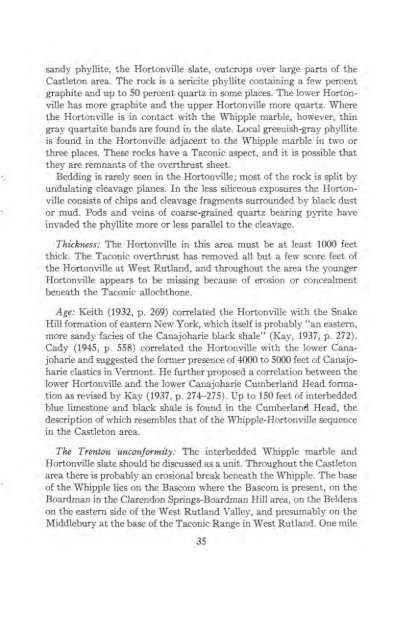STRATIGRAPHY AND STRUCTURE CASTLETON AREA VERMONT
STRATIGRAPHY AND STRUCTURE CASTLETON AREA VERMONT
STRATIGRAPHY AND STRUCTURE CASTLETON AREA VERMONT
Create successful ePaper yourself
Turn your PDF publications into a flip-book with our unique Google optimized e-Paper software.
sandy phyllite, the Hortonville slate, outcrops over large parts of the<br />
Castleton area. The rock is a sericite phyllite containing a few percent<br />
graphite and up to 50 percent quartz in some places. The lower Hortonyule<br />
has more graphite and the upper Hortonville more quartz. Where<br />
the Hortonville is in contact with the Whipple marble, however, thin<br />
gray quartzite bands are found in the slate. Local greenish-gray phyllite<br />
is found in the Hortonville adjacent to the Whipple marble in two or<br />
three places. These rocks have a Taconic aspect, and it is possible that<br />
they are remnants of the overthrust sheet.<br />
Bedding is rarely seen in the Hortonville; most of the rock is split by<br />
undulating cleavage planes. In the less siliceous exposures the Hortonyule<br />
consists of chips and cleavage fragments surrounded by black dust<br />
or mud. Pods and veins of coarse-grained quartz bearing pyrite have<br />
invaded the phyllite more or less parallel to the cleavage.<br />
Thickness: The Hortonville in this area must be at least 1000 feet<br />
thick. The Taconic overthnist has removed all but a few score feet of<br />
the Hortonville at West Rutland, and throughout the area the younger<br />
Hortonville appears to be missing because of erosion or concealment<br />
beneath the Taconic allochthone.<br />
Age: Keith (1932, p. 269) correlated the Hortonville with the Snake<br />
Hill formation of eastern New York, which itself is probably "an eastern,<br />
more sandy facies of the Canajoharie black shale" (Kay, 1937, p. 272).<br />
Cady (1945, p. 558) correlated the Hortonville with the lower Canajoharie<br />
and suggested the former presence of 4000 to 5000 feet of Canajoharie<br />
clastics in Vermont. He further proposed a correlation between the<br />
lower Hortonville and the lower Canajoharie Cumberland Head formation<br />
as revised by Kay (1937, p. 274-275). Up to 150 feet of interbedded<br />
blue limestone and black shale is found in the Cumberland Head, the<br />
description of which resembles that of the Whipple-Hortonville sequence<br />
in the Castleton area.<br />
The Trenton unconformity: The interbedded Whipple marble and<br />
Hortonville slate should be discussed as a unit. Throughout the Castleton<br />
area there is probably an erosional break beneath the Whipple. The base<br />
of the Whipple lies on the Bascom where the Bascom is present, on the<br />
Boardman in the Clarendon Springs-Boardnian Hill area, on the Beldens<br />
on the eastern side of the West Rutland Valley, and presumably on the<br />
Middlebury at the base of the Taconic Range in West Rutland. One mile<br />
35













